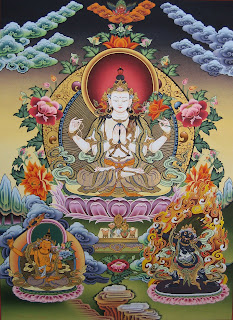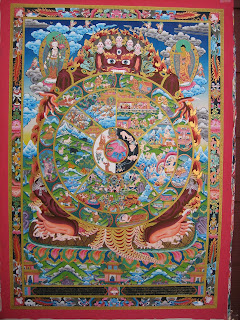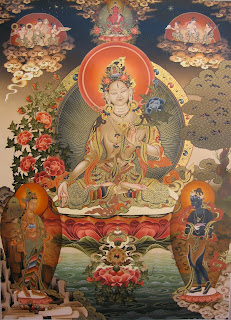We hope to have you join us for our July 27th event at Kush gallery-- a truly unique exhibition of one-of-a-kind hand-painted Tibetan Thangkas.
Thangkas are Buddhist banners traditionally hung in monasteries and family altars and carried by lamas in ceremonial processions. For many centuries traveling monks carried them from monastery to monastery throughout Asia to serve as teaching tools depicting the life of Buddha. For believers, their stunning colors and intricate geometric forms steeped in symbolism and allusion make them manifestations of the divine.
Lester Lamm, a Portland resident and principal at Western States Chiropractic College, has spent much of his life traveling to and around Nepal. While living in Katmandu as a young man, a remarkable series of circumstances led him to develop a love for the art of new Buddhist Thangka. Over the years he has accumulated an impressive collection of the most beautiful examples of this ancient and fascinating art form. Lester has forged personal relationships with all of the artists he buys from in Nepal, placing emphasis on quality and integrity of work and helping to ensure these artists are able to continue to make a living from their craft, and to do so with artistic and personal freedom.

The event at Kush gallery on July 27th will feature these artists' paintings, some of which will be for sale. My motivations and goals for this "show" are anchored in a fundamental desire to assist in the cultivation and sustainability of cultural and spiritual art forms all over our earth. It is my belief that our appreciation for, and support of these timeless crafts helps culture survive.
Karcheung’s story, how it all began:
Lester Lamm was living in Kathmandu in a rented house in a compound, working as a chiropractor—the first in Katmandu. The compound, owned by a military captain, was home to around 7 other families. This captain had a wife and two children, a son and a daughter. One night the son of the captain knocked on Lester's door to say that the boy in a neighboring house, the poorest house in the compound, was sick and would Lester come to look in on him. Which he of course did, and he helped the boy back to health.
A couple months later there was a late night knock on Lester’s door and it was this same boy with a Thangka rolled up in his arms and a translator by his side. The Thangka was an extraordinary Buddha Thangka with a traditional cloth brocade border; the boy was offering it as a gift. Lester at first refused but was quickly instructed by the translator that you really can't refuse a gift and so Lester graciously accepted but said "Why would you buy me this wonderful gift?"
To which the boy replied "I did not buy it, I painted it."
To which Lester replied "Well, you do wonderful work, is there any way that I can purchase another?"
The boy, Karcheung, replied "I cannot, I work for a man to whom I am deeply indebted and I cannot work for anyone else. Everything that I do belongs to this man."
Lester replied “How is it that you did this one?"
"I stayed up very late, after dark, and worked on it every night after work."
It was a secret, you see.
Karcheung’s story is reminiscent of that of many young Thangka artists who come to Kathmandu from the hills outside the city. He had come looking for work as a painter and was approached by a man who promised him the world. The man gave him a place to live, clothes to wear and food to eat, a cassette recorder and other wonderful things, all the while telling him how much money he'd make as a Thangka painter. The truth was that this man owned a sweat shop and acquired all his "artists" this way.

Before long Karcheung found himself deeply in debt and unable to even pay for rent, so he moved into the sweatshop and produced subpar Thangkas for his master. These are what you find on the tourist market, these mass produced pieces. Karcheung’s debt, a mere $85, would likely take a lifetime of work to repay. Lester decided that he wanted to buy the boy out of this artistic servitude and approached the owner who at first objected, preferring instead to have the labor of this boy. But when Lester threatened to take up the matter "under the tree," (which is where squabbles were legally settled) the man conceded defeat, took his payment and Karcheung was free.
Karcheung offered to paint Thangkas very fast but Lester encouraged him to paint slowly, to look towards quality, not quantity, and after a time he became very good at the art. He now has 3 wives, owns a farm in his village, supports a Thangka concern of his own in Kathmandu where he treats his artist very well, and was the first master to hire women.
The rest is, as they say, history.










